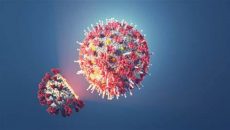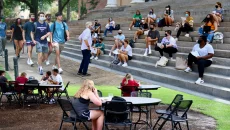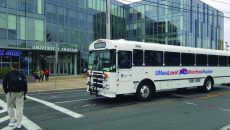(Photo courtesy of UMass Lowell) Due to the low number of students, there has been a low number of shuttles in operation, leading to the shuttles cutting down their services.
Merrick Tull-Johnson
Connector Contributor
With COVID surging through the U.S., the survival tactic became “adjust.” UMass Lowell has been the epitome of “adjust” since COVID has made life difficult for everyone. The school’s biggest adjustment was the plan to implement phases to keep the positive test rates on campus down.
Phase one kept the students out of the lounges until Feb. 15, with the times ranging from 7 p.m. to midnight. Phase two, on the other hand, will not be in motion until fall. Restrictions will be much looser in allowing the students to be more social or continuing isolation. The closing of the Solution Center, the closing of the Recreation Center (except the gym) and the creation of more hybrid classes (in-person and online classes) are some of the minor changes that come with this phase.
Although these changes are happening, the amount of students living on campus are still low. Even with the amount of students being low, the little things had to be changed. One of those “little things” that had to be changed or adjusted was the transportation system on campus. Due to the low number of students (there were over 1100 students and now there are less), there has been a low number of shuttles in operation, leading to the shuttles cutting down their services.
“We had shuttles for a demand of 175 kids per day,” said Director of Administrative Services Nick Piscitello. “The students using the shuttles have been below 100, and the amount of heightened parking spaces have students opting out of using the shuttles to drive.”
Although the numbers have been low and the shuttles are few, transportation services are still taking safety precautions to make sure that students and drivers are safe. Some of these precautions that transportation services has taken include requiring that masks are worn, mandating students to sit at every other seat, placing liners in between drivers, using electric status sprayers after every shift, and sanitizing vehicles for 24 hours. Drivers are also asked to take the initiative to clean the high-touch areas in the shuttles. Despite the turmoil, hopes that things will get back to normal within the transportation services are still high.
“My hope is that we will return to a more community-based environment that resembles a pre-COVID lifestyle where people feel comfortable and safe,” Piscitello said. “We want students to want to confidently use our shuttles because not only are they convenient, but they also reduce traffic. My hope is that we are adaptable and able to respond to what is needed.”
Karina Cruz, assistant director of Parking & Transportation, said, “My hopes are that we can bring back a robust team similar to pre-COVID. I, too, hope we can get back to normalcy.”
If able to return to a pre-COVID lifestyle, there will be rides to events, weekend services, and more available rides at night. Not only that, but there will also be more familiar faces driving the shuttles.




